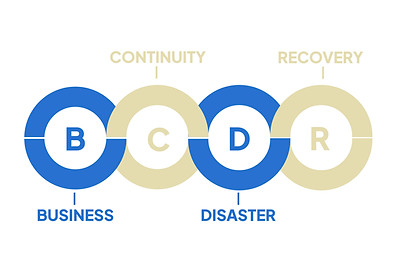BC/DR Planning
Business Continuity and Disaster Recovery Planning. It's a comprehensive strategy and set of processes an organization develops to ensure the continued operation of essential business functions before, during, and after a disruptive event.
Business Continuity focuses on maintaining critical business functions and processes during and immediately after a disruption, ensuring that the organization can continue to operate and deliver products or services. It's about keeping the business running in the face of adversity.
-
Key Focus: Maintaining operations, even in a degraded state. It considers the entire organization, including people, processes, technology, and facilities.
-
Objectives:
-
Minimize downtime and financial losses.
-
Protect the organization's reputation and brand.
-
Ensure the safety of employees and stakeholders.
-
Meet regulatory and compliance obligations.
-
Maintain customer satisfaction.
-
-
Activities Involved:
-
Business Impact Analysis (BIA): Identifying critical business functions, processes, and systems, and assessing the potential impact of their disruption (financial, reputational, legal, operational). This helps determine Recovery Time Objectives (RTO) – the maximum tolerable time a system or function can be down, and Recovery Point Objectives (RPO) – the maximum tolerable amount of data loss.
-
Strategy Development: Designing strategies to continue critical operations, which might include alternate work sites, cross-training staff, manual workarounds, or leveraging third-party services.
-
Plan Development: Documenting detailed procedures and responsibilities for responding to various scenarios.
-
Testing and Maintenance: Regularly testing the plan to identify gaps and updating it as business processes, technology, or risks change.
-
Crisis Management: Establishing a framework for decision-making, communication, and coordination during a crisis.
-
2. Disaster Recovery (DR) Planning:
Disaster Recovery is a subset of Business Continuity that specifically focuses on the recovery of an organization's IT infrastructure and data after a disaster. It's about restoring the technology systems and data that support critical business functions.
-
Key Focus: Restoring IT systems, applications, and data.
-
Objectives:
-
Restore IT services to an operational state within defined RTOs.
-
Recover data with minimal loss, adhering to defined RPOs.
-
Ensure data integrity and security during recovery.
-
-
Activities Involved:
-
Data Backup and Restoration: Implementing robust backup solutions (e.g., tape, disk, cloud) and strategies (e.g., full, incremental, differential backups) to ensure data can be recovered.
-
Off-site Storage: Storing backups and critical documentation in a geographically separate location.
-
Redundant Infrastructure: Establishing redundant hardware, software, and network components. This could involve hot sites (fully equipped alternate data centers), warm sites (partially equipped), or cold sites (basic infrastructure).
-
Cloud-based DR Solutions: Leveraging cloud providers for replication, failover, and rapid recovery of virtual machines and data, often providing more cost-effective and flexible DR options.
-
Network Recovery: Plans for restoring network connectivity, including internet access, internal networks, and remote access.
-
Application Recovery: Procedures for restoring and reconfiguring critical business applications.
-
DR Testing: Regularly performing simulations and drills to validate the recovery processes and ensure IT staff can execute them effectively.
-
The Relationship Between BC and DR:
BC/DR planning is an integrated approach where:
-
DR is a component of BC: You can't have effective business continuity without a solid disaster recovery plan for your IT systems, as most modern businesses are heavily reliant on technology.
-
BC provides the context for DR: The BIA conducted during BC planning defines the RTOs and RPOs for IT systems, guiding the development of the DR plan. BC determines what needs to keep running and how quickly, and DR defines how the supporting IT infrastructure will be restored to enable that.
-
Together, they provide resilience: A well-executed BC/DR plan ensures that an organization can withstand various disruptions—from natural disasters and cyberattacks to power outages and pandemics—and quickly return to normal operations, minimizing damage and maintaining trust.
In summary, BC/DR Planning is crucial for organizational resilience, risk management, and maintaining competitive advantage in an unpredictable world.
